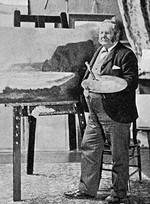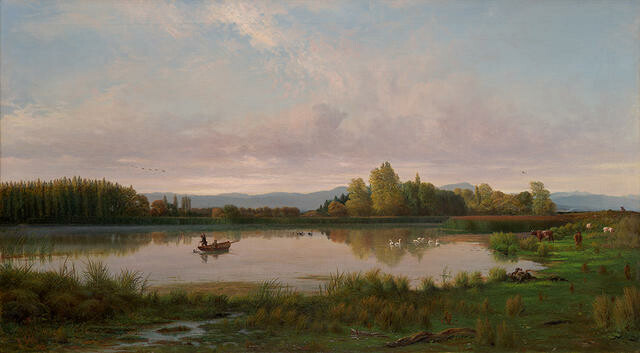John Gibb
Scotland / Aotearoa New Zealand, b.1831, d.1909
Clearing up after Rain, Foot of Otira Gorge
- 1887
- Oil on canvas
- Purchased 1964
- 1020 x 1450 x 45mm
- 69/154
- View on google maps
Location: Sir Robertson and Lady Stewart Gallery
Tags: animals, buildings (structures), carriages (vehicles), clouds, horses (animals), hotels (public accommodations), landscapes (representations), mountains, natural landscapes, roads, whips (animal equipment)
About the artist

John Gibb in his studio
The Weekly Press, 12 December 1900, p. 62
Image supplied by Christchurch City Libraries (CCL-PhotoCD07-IMG0022)
From 1885 on, Scottish painter John Gibb took repeated sketching trips to Ōtira Gorge, a destination advertised in daily newspapers as offering “The Grandest Scenery in the World”. Travelling to Ōtira from Ōtautahi Christchurch at the time was quite an undertaking: a train journey to Tawera Springfield was followed by a jolting stagecoach trip through the Bealey district and Arthur’s Pass, and the accommodation options on arrival were basic. The horse-drawn travelling party pictured here had crossed Kā Tiritiri-o-te-moana Southern Alps, but were yet some hundred kilometres from their journey’s end at Hokitika on Te Tai Poutini West Coast.
He Kapuka Oneone – A Handful of Soil (from August 2024)
Exhibition History
John Gibb, 18 December 2015 – 28 August 2016
The wild and rugged mountainous landscape of Otira has captivated visitors since the first road was cut through the gorge in the mid-1860s. Otira is the Māori place name for this region and translates as ‘the last rays of the sun’. It was a landscape that Gibb was drawn to, and he returned to paint it repeatedly throughout his career. An unforgiving place with high rainfall, rivers can rise suddenly and fill the gorge with the thundering noise of falling water. Gibb has painted the aftermath of one such storm in this work. The original Otira Hotel depicted in this painting was washed away when the Otira River flooded in 1886.
Van der Velden: Otira, 11 - 22 February 2011
One of the most successful Canterbury painters of the nineteenth century, John Gibb first visited the Otira region in 1877 and returned to the area regularly throughout his career. In Clearing up after rain, foot of Otira Gorge, Gibb depicts the original Otira Hotel at the foot of the gorge – a staging post for coach traffic in the early days of transport between Canterbury and Westland. This hotel was washed away when the Otira River flooded in 1886. The road leading up the Otira Gorge to Arthur’s Pass is seen to the left of the hotel, while Mount Rolleston creates a imposing backdrop to the scene.
About 4 kilometres south of Otira, in the Southern Alps, is the Otira Gorge, the original staging place for coach traffic in the earlier days of transport between Canterbury and Westland via Arthur's Pass. The hotel in Otira, seen in this work, was washed away when the Otira River flooded in 1886. John Gibb painted this work the following year, 1887, in his Christchurch studio from sketches and studies he made on previous visits to Otira. It is painted in the precise academic realist manner in which he had been trained in Scotland. Gibb was born in Cumbernauld, Scotland. He received tuition from John McKenzie at Greenockand, in 1861, began exhibiting at the Royal Scottish Academy. In 1868, however, he began exhibiting at the more progressive Royal Glasgow Institute of Fine Arts. Gibb emigrated to New Zealand in 1876. He settled in Christchurch, was a founding member of the Canterbury Society of Arts and travelled widely in New Zealand, painting many different regions. (Gallery opening hang, May 2003)














